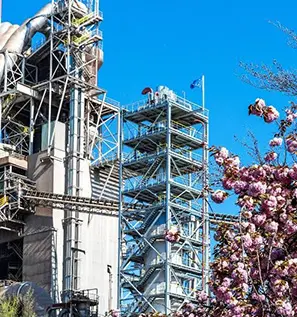"A wonderful thing about developing a new, promising industrial technology is being able to choose core partners that share your values, and we struck gold with Qarnot. Like us, Qarnot is mission-driven. It has a unique IT infrastructure distributed across Europe, which provides green cloud computing services that reuse heat released by their servers"
Vincenzo Panebianco · CFD & Combustion Development Engineer

Leilac is accelerating a just transition to net zero by providing the most compelling decarbonization solution for global cement and lime industry.
Leilac’s kiln technology efficiently separates unavoidable carbon emissions ready for use or storage, without additional chemicals or processes. It is designed to be scalable, retrofittable, energy agnostic and electrification ready, providing flexible and economical pathways to carbon free cement and lime.
Performing CFD simulations at industrial scale requires considerable time and storage if a standard workstation is used, but computations can be scaled down if multiple cores are used in parallel. The only practical way to run these kinds of high quality CFD investigations in a reasonable timeframe is using high-performance computing resources from a company like Qarnot.
Creating massive computing clusters brings its unique challenges, as bottlenecks may appear which will slow down the simulation speedup. Qarnot's unique software and hardware expertise helped us choose the perfect configuration depending on the simulation size and the time restrictions.
By using Qarnot, we have access to multiple licensing options, which can be chosen depending on the current need, including bring your own license (BYOL), hosted on the cloud or on-demand with elastic core scaling.
Qarnot's engineers are committed to understanding our needs, ensuring prompt and responsive support.
Qarnot reduces the energy needed to cool its machines through the re-use of waste heat to provide large-scale site with significant heat needs and reduces the carbon footprint of IT workloads by 80%. In this way, Leilac and Qarnot are working together to reduce the environmental impact of our activities.
Leilac’s decarbonisation technology is centred around the use of heat to separate and capture carbon dioxide (CO2) emissions from limestone, which are an unavoidable result of the industrial process of making cement and lime. It’s not a small thing. CO2 emissions from cement are estimated to be between 6-8% of annual worldwide emissions, with a little over 1% more coming from lime.
To make our technology work, we need to perform complex simulations, using Computational Fluid Dynamics (CFD) to ensure that heat is used efficiently and responsibly at both smaller and lager industrial scales. High quality CFD analysis allows us to “look inside” our kilns, and deeply understand how heat behaves.
It’s complicated because many factors influence the way limestone reactions happen, such as temperature and pressure, flue gas composition, exchanging surface areas, and fuel choice. It is almost impossible to watch the actual reaction taking place inside an extremely hot kiln, which is why this process is so fascinating and almost magical. Thus, it’s this “magic” that our combustion and cement experts are trying to understand by using powerful simulation tools like CFD.